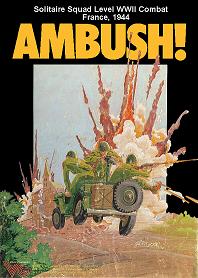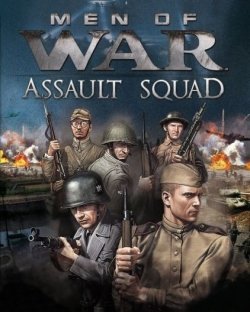
A wargame is a strategy game in which two or more players command opposing armed forces in a simulation of an armed conflict. Wargaming may be played for recreation, to train military officers in the art of strategic thinking, or to study the nature of potential conflicts. Many wargames re-create specific historic battles, and can cover either whole wars, or any campaigns, battles, or lower-level engagements within them. Many simulate land combat, but there are wargames for naval, air combat, and cyber as well as many that combine various domains.

Ambush! is a man-to-man wargame developed by Avalon Hill. It was released under Avalon's Victory Games label and was developed by Eric Lee Smith and John Butterfield. It has been out of print since Avalon Hill was disbanded in 1998.

PanzerBlitz is a tactical-scale board wargame published by Avalon Hill in 1970 that simulates armored combat set on the Eastern Front of World War II. The game, which was the most popular board wargame of the 1970s, is notable for being the first true board-based tactical-level, commercially available conflict simulation wargame. It also pioneered several concepts that would become industry standards.

Squad Leader is a tactical level board war game originally published by Avalon Hill in 1977. It was designed by John Hill and simulates on infantry combat in Europe during World War II. One of the most complex war games of its time, Squad Leader is the natural extension of the trend towards greater realism initiated by several earlier games, including Avalon Hill's own PanzerBlitz and Panzer Leader. Those two earlier games were slightly larger in scope, with counters representing platoons and map hexes measuring 250 metres across, compared to Squad Leader's 40 meter hexes and squad sized units.

Armor Alley is a computer wargame for DOS and Mac OS published by Three-Sixty Pacific in 1991. It is modelled on the Apple II game Rescue Raiders. Player can compete against the computer or other humans via LAN. The game supports cooperative multiplayer of up to two players per side. The player controls a helicopter armed with a limited number of munitions, such as missiles, bombs, machine guns, and napalm. As the player requisitions computer-controlled tanks, infantry, engineers. Mobile missile platforms, and vans round out available firepower.

A man-to-man wargame is a wargame in which units generally represent single individuals or weapons systems, and are rated not only on weaponry but may also be rated on such facets as morale, perception, skill-at-arms, etc. The game is designed so that a knowledge of military tactics, especially at the small unit or squad level, will facilitate successful gameplay. Man-to-man wargames offer an extreme challenge to the designer, as fewer variables or characteristics inherent in the units being simulated are directly quantifiable. Modern commercial board wargaming stayed away from man-to-man subjects for many years, though once the initial attempts were made to address the subject, it has evolved into a popular topic among wargamers.

Tactical wargames are a type of wargame that models military conflict at a tactical level, i.e. units range from individual vehicles and squads to platoons or companies. These units are rated based on types and ranges of individual weaponry. The first tactical wargames were played as miniatures, extended to board games, and they are now also enjoyed as video games.
Turn-based tactics (TBT) is a sub-genre of strategy video games. They are turn-based simulations of operational warfare and military tactics in generally small-scale confrontations as opposed to more strategic considerations of turn-based strategy (TBS) games. Turn-based tactical gameplay is characterized by the expectation of players to complete their tasks using only the combat forces provided to them in a generally realistic manner.
Real-time tactics (RTT) is a subgenre of tactical wargames played in real-time, simulating the considerations and circumstances of operational warfare and military tactics. It is differentiated from real-time strategy gameplay by the lack of classic resource micromanagement and base or unit building, as well as the greater importance of individual units and a focus on complex battlefield tactics.

Tactics is a board wargame published in 1954 by Avalon Hill as the company's first product. Although primitive by modern standards, it and its sequel, Tactics II, signalled the birth of modern board wargaming for the commercial market. Tactics is generally credited as being the first commercially successful board wargame.
Atomic Games, Inc. was an American video game developer based in Austin, Texas, specializing in wargames. The company was founded by Keith Zabalaoui in 1989, and is best known for developing the Close Combat series of real-time wargames, as well as the V for Victory series. In December 2000, due to the cancellation of a project titled Hammer's Slammers, Atomic Games laid off its entire staff, only keeping three executives. Atomic Games was acquired by Destineer on May 6, 2005, while collaborating on Close Combat: Red Phoenix and Close Combat: First to Fight. Atomic Games was developing a third-person shooter, Six Days in Fallujah, in cooperation with Konami, until the latter decided to withdraw from the project in August 2009, causing significant layoffs at Atomic Games. The company went on to finish the game, but never released it. Atomic Games released the game called Breach, which is a multiplayer-only downloadable first-person shooter. Destineer also owned Bold Games, and MacSoft, who also went down with Destineer

Close Combat: A Bridge Too Far, or Close Combat II, is a World War II real-time computer wargame, developed by Atomic Games, and released on October 13, 1997. The second installment of the Close Combat series, the game is played on a two-dimensional map, between two players.

Close Combat is a 1996 real-time computer wargame developed by Atomic Games and published by Microsoft. Set during World War II, it simulates the conflict between the United States' 29th Infantry Division and Germany's 352nd Infantry Division after the Invasion of Normandy. The player controls an artificially intelligent army whose behavior is dictated by psychological models: each soldier makes decisions based on the circumstances of the battlefield and can disobey the player's orders.
Strategy is a major video game genre that emphasizes thinking and planning over direct instant action in order to achieve victory. Although many types of video games can contain strategic elements, as a genre, strategy games are most commonly defined as those with a primary focus on high-level strategy, logistics and resource management. They are also usually divided into two main sub-categories: turn-based and real-time, but there are also many strategy cross/sub-genres that feature additional elements such as tactics, diplomacy, economics and exploration.

Combat Mission is the name of a series of computer wargames simulating tactical battles. The series has progressed through two distinct game engines. The original game engine, referred to as 'CMx1' by the developer, Battlefront.com, powered a trio of games set in the Second World War. Combat Mission: Shock Force was released in July 2007 as the debut of the 'CMx2' game engine. The Combat Mission games are a mixture of turn-based gameplay and simultaneous real-time execution. The game environment is fully three-dimensional, with a "Wego" style of play wherein each player enters their orders into the computer simultaneously during pauses in the action, and then are powerless to intervene during the action phase. More familiar turn-based games use an "I-go/You-go" system of play.

Men of War: Assault Squad is a game of real-time tactics strategy game set in World War II.
Men of War is a real-time tactics video game franchise, based mainly in World War II.

Operation Crusader is a 1994 computer wargame developed by Atomic Games and published by Avalon Hill.

A wargame is a strategy game that realistically simulates warfare. Wargames were invented for the purpose of training military officers, but they eventually caught on in civilian circles, played recreationally.

MBT is a board wargame published by Avalon Hill in 1989 that simulates hypothetical World War Three tank combat between NATO and Warsaw Pact forces in Western Europe. A second edition was published by GMT Games in 2016.















